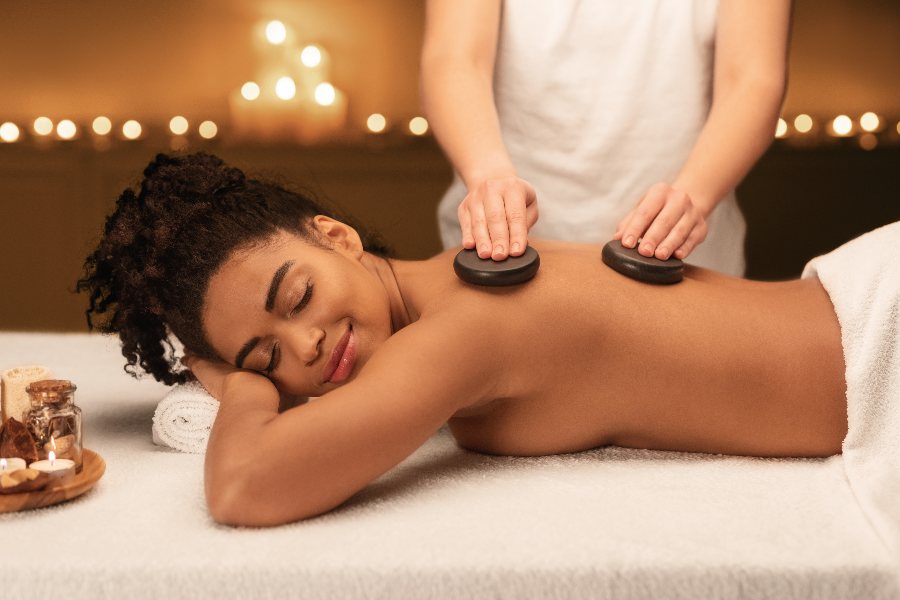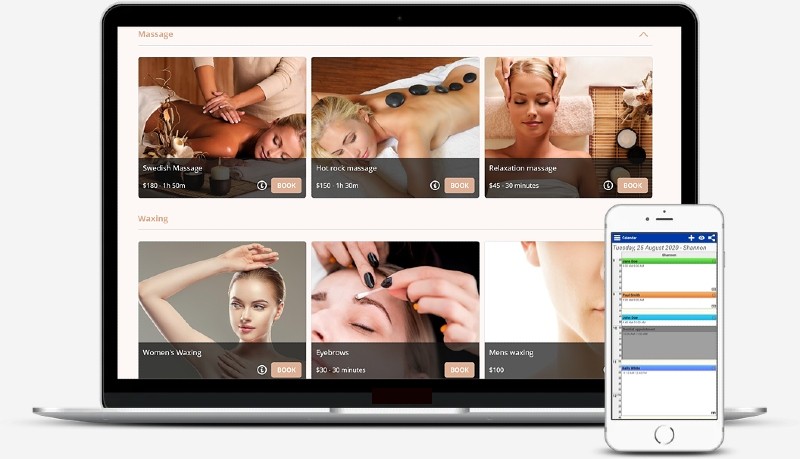
Massage Therapy Marketing Ideas, Tips, and Strategies
Thinking about starting a massage therapy business? Whether you are an experienced massage therapist or just starting out, a massage therapy business can be an exciting and potentially profitable business opportunity.
Yes, the massage industry has been heavily affected by the global COVID-19 pandemic. However, in 2021, it has shown strong signs of bouncing back. Don’t underestimate the fact that it is a massive, $18 billion industry that is still growing steadily.
However, just because it’s a promising business opportunity, doesn’t mean you’ll automatically attract many clients and grow your business as soon as you’ve set up your massage therapy clinic. You’ll still need proper market research and carefully plan your marketing strategy to ensure success.

With that being said, in this guide, we will share marketing ideas, tips, and strategies for promoting a marketing therapy business.
By the end of this guide you’d have learned about:
- Market research and competitive analysis for a massage business
- Four marketing pillars for a service-based business
- Tips and actionable strategies you can use to market your massage therapy business
And more.
Without further ado, let us begin right away.
Market Research and Competitive Analysis for Massage Therapy Businesses
A very important principle to understand is that your marketing efforts, no matter how good they are, won’t matter much if you are not targeting the right audience. Many businesses are targeting the wrong audiences, and so their marketing isn’t effective, or worse, they are targeting markets that don’t exist.
This is why it’s important to first perform market research before you even start committing to start the massage therapy business.
Your market research should assess three main areas:
- Whether there is indeed a viable market with sufficient size for your massage therapy service
- As much information about your potential target market (if any): demographics, behavior, psychographics, location, social media activities, and more.
- Your potential competitors in the area, whether you can compete with them (or beat them), and how.
Nowadays, you can use various tools online (even Google) to perform basic market research. For example, a quick Google search with queries like “massage clinic in (city name)”, “massage therapy near me”, or similar ones will let you easily find nearby massage therapy businesses.

These are your potential competitors.
You can then research these businesses further, and if necessary, visit them one by one to check how busy they are, their clients (which are potentially your clients), how they market their business, and more.
Depending on your location, this might be enough, but if necessary you can get help from professional agencies in your area to determine the feasibility of your business.
Develop a Buyer Persona
Once you’ve performed adequate market research and competitive analysis, the next step is to develop a buyer persona.
A buyer persona, simply put, is a fictional model of your perfect client.
To develop your buyer persona you should answer these key questions:
- Who are they? Demographics data like age, location, gender, and so on.
- What do they do? Whether they are employees, business owners, or students.
- What’s their average day like? Describe what an average day is like for your target customer (i.e. a stay-at-home mom, an employee working with X, etc.)
- Where do they go for information? Social media, from their friends, browsing, and so on
- What type of content/information do they prefer? The type and style of content they are seeking.
- What’s important for them when selecting a massage therapist? List what’s most important for them.
- What are their most common objections? List potential obstacles to not choosing your massage service.
And so on.
Be as detailed and accurate as possible when developing your buyer persona. Your marketing strategy will only be as good as how well you understand your target audience. So don’t underestimate the importance.
Also, remember that your buyer persona shouldn’t be static. Evaluate and update your buyer persona regularly by performing another market research and competitive analysis so you can keep up with the changes in trends and customer behaviors.
Four Pillars of Massage Therapy Marketing Strategies
Now that we’ve performed market research, competitive analysis, and have developed a buyer persona for a massage therapy business, we can move on to discussing the marketing strategy.
A massage therapy business, as we know, is a service-based business with client appointments at its core. Thus, as with similar businesses, marketing strategies for these massage businesses should mainly focus on the following areas:
1. Branding
If you are a stationary massage business with a physical location, then it’s virtually impossible to survive from walk-ins alone.
It’s crucial to make sure your potential clients know your location, what you do, and especially why they should come to you instead of your competitors.

The solution? Building a recognizable and trustworthy brand. Branding should be the foundation of your overall marketing strategy, and without strong branding in the first place, you won’t be able to develop a successful marketing strategy. You can start off by using a business name generator and online design tools to establish the visual aspect of your brand.
Below are some tips to consider when building a strong brand for your massage therapy business:
- The key to strong branding is how well you understand your target audience. Create a buyer persona and gather as much information about your ideal audience. The idea is to build a brand that will appeal to this audience.
- Choose a unique brand name that is also easy to pronounce and easy to remember.
- Perform competitive analysis, check how your competitors are naming their brand
- In today’s digital age, a core aspect of branding is also about establishing a strong online presence and maintaining a positive online reputation. You must have a professional-looking and functional website, social media presence, and a high enough ranking on Google Maps listing. We’ll discuss online presence again in the next point.
- Brand consistency is very important. Everything from your website, social media, and walking through your massage clinic’s doors should look and feel the same. This is a very important key in building a strong and memorable brand.
2. Online Presence
We’ve briefly discussed how your massage therapy business’s online presence can make or break your business, and we can further divide online presence into four major elements:
- A professional website
- Social media presence
- Online reservation
- Google Maps SEO
Let’s discuss them one by one.
A professional website
In this digital age, a website can be considered the digital equivalent of your storefront.
With a well-designed, functional, and reliable website, you are technically available 24/7 for potential clients. An informative and attractive website will encourage your visitors to book a massage session.
Nowadays, setting up a WordPress-based website is fairly easy (and free) although you’ll need a bit of programming knowledge. However, there are also services like Wix or Squarespace that allow you to easily build a well-designed website with a drag-and-drop visual builder.
So, there’s simply no excuse not to have a well-designed website for your massage therapy business.
Make sure your website is:
- Easy to navigate with intuitive, well-designed user experience elements
- Have great content, especially information about what services you provide, your prices, your address/contact information, and so on
- Mobile-friendly, test on as many mobile devices as possible, and use Google’s mobile-friendly test tool
- Make sure your page loads fast, less than 3 seconds on standard 4G connectivity.
- Ideally, your website should have online reservation functionality, which we will discuss again below
Social media presence
With how most if not all of our target audiences are active on social media, it would only make sense to promote your business on relevant social media platforms.
For massage therapy businesses, Instagram, Facebook, and Pinterest are the main platforms you should focus on, but you can also build your presence on other platforms like Twitter, Linked In, or even YouTube depending on your market demographics.

The thing is, virtually all your competitors are also marketing themselves on social media, so how can you stand your massage business apart amidst all of these noises?
Creativity is key, but we have to also consider the fact that we have three different options in establishing social media presence:
- Organic: building your own followers by regularly publishing your content (i.e. interesting posts about your massage therapy)
- Paid: using paid options offered by the social media networks (i.e. Facebook Ads) to generate quick results.
- Influencer: partnering with relevant influencers that might help in promoting your massage business
The secret is finding the right balance between the three, which is essentially the case of time vs cost:
Organic social media marketing is obviously the most affordable (and even totally free), but it will take some time (even years) before you can build enough followers and generate more leads from these social networks. Paid options, on the other hand, will guarantee quick and even instant results, provided you have the budget.
We can think of influencer marketing as somewhere in the middle between the two. Consider partnering with health/wellness, beauty, and fashion influencers in your area so they can help promote your massage therapy business.
Online reservation
Consider the fact that 40% of online bookings nowadays actually happen after hours. People are getting busier and would appreciate flexibility, and online reservation is now a must.
Make sure it’s as easy as possible for your clients to book your massage therapy sessions, and this is why you should integrate a reliable online appointment scheduler to your website and social platforms.

Phone-based and email-based appointments simply won’t cut it anymore.
Google Maps SEO
One of the primary ways people learn about local business is via Google search for queries like “massage therapy near me” or similar ones.
The thing is, for these queries, Google will prioritize results from Google Maps, which are placed on top of the organic results on the SERP. The solution? Google Maps SEO or Local SEO to make sure our Google Maps listing stays on top of the Google Maps results, and we can do this in four fairly simple steps:
- Claiming and verifying Google Maps/Google My Business listing
- Optimizing your Google My Business Listing, focus on providing accurate and complete information for your users.
- Building local citations by listing your massage business on relevant online directories
- Getting more reviews from existing clients, especially on Google Maps but also on relevant review sites/platforms
Do these four steps consistently, and your massage therapy business’s listing will slowly but surely climb the Google Maps ranking.
3. Customer Loyalty
In marketing our massage therapy business, it’s crucial to remember that your efforts should not only focus on acquiring new customers, but also on retaining existing clients so they’ll keep coming again and again.
In fact, retaining the right clients can be much more profitable than getting new clients to visit your business, so don’t take your existing clients for granted.
Repeat business is key in running a successful massage therapy business, and if you’ve implemented an online reservation system, you’ll automatically capture contact information to the online reservation system’s database.
You can then use this contact information to launch your customer loyalty campaigns, such as:
- Email marketing
Even with all the newer technologies and marketing channels, email marketing is still very effective with one of the highest ROIs.
Email marketing is especially great in nurturing existing clients. You can, for example, send an email offering a discount when a client hasn’t booked your service in more than two months. You can also offer seasonal/special promotions from time to time and also use emails to send useful information (i.e. useful health tips, meditation, tips, etc.)
- SMS marketing
Similar in principle to email marketing, SMS marketing can be effective in offering promotions, sending appointment notifications, and more. If your online reservation system has a built-in SMS notification function, then you should definitely put it to good use.
- Loyalty system
Everyone loves exclusivity and being appreciated, and a loyalty system is great for offering exclusive loyalty discounts and other special promotions to keep clients coming back. Use SMS and email marketing to send promotions for these special offers and you’ll get more and more repeat appointments.
4. Advocacy and Word-of-Mouth Marketing
As a local business, it’s important to leverage referrals and word-of-mouth marketing as much as possible. If each of your clients recommends your massage therapy service to just one of their friends, you technically double the number of clients.
The ultimate dream of any marketing effort is to have your satisfied clients recommend your services for free, a thing we know as customer advocacy. There’s no shortcut in achieving this besides actually giving your clients an amazing massage experience, but there are some ways that may help:
- Encourage reviews
Nowadays, online reviews are just as, if not even more valuable than traditional word-of-mouth marketing. Close to 100% of customers read online reviews when researching between different businesses, so it’s very important to ensure they can easily find (positive) reviews of your massage therapy business.

You can offer incentives to encourage more of your clients to leave their reviews, for example offering a 10% discount in exchange for a Google Maps review or Instagram mention.
Sometimes, however, all it takes is to ask your clients at the right time. Timing is key, for example, ask them once they’ve come the second time (repeat appointment signifies satisfaction).
- Start referral and affiliate campaigns
People often go to a massage clinic together with their spouses or friends. Leverage this by offering a group discount promotion where a client will get a certain percentage off their price when they bring someone else to your business.
You can also run a referral campaign, for example by offering commissions to existing clients for every customer who comes to the massage clinic and mentions the client’s name (or referral code).
Lastly, you can encourage influencers to help promote your massage therapy business by running an affiliate marketing campaign. You can offer affiliate codes for influencers so that they’ll get commissions for clients that book your sessions with this code.
Additional Marketing Ideas, Tips, and Strategies
Based on the four pillars we’ve discussed above, we can expand our marketing strategy with the following tactics:
The Foundation: Superior Service and Experience
Above anything else, it’s important to establish the very foundation of successful marketing: your service quality.
Your clients come to you because they have a problem they need to be addressed: muscular pain, neck pain, back pain, and so on. Make sure you provide the best possible service so they are convinced that you are indeed the best possible solution for their problem.
This is what keeps them coming back, and even better, recommend your service to their peers and family members. This is how you retain clients and naturally grow your business.
Partnering With Local Businesses
While in this digital age you should focus most of your marketing efforts online, don’t underestimate the importance of offline marketing like partnering with non-competitive businesses in your area.
The massage therapy business belongs in a large and diverse health and wellness industry, so you can potentially partner up with businesses that share similar missions and values such as:
- Gyms
- Spa centers
- Makeup artists
- Hairdressers/stylists
- Dietitians and nutritionist
- Holistic medicine practitioners
And more.
Chances are, these businesses will have clientele similar to your own, so you can perform cross-promotion campaigns together. For example, you can offer 10% discounts for members of your local gym, and vice versa this gym will offer discounts or free trials for your clients.
Also, businesses like gyms or salons might be looking for massage therapists to diversify their services, so you can probably rent out a room from them and expand your clinic (by hiring additional therapists if necessary).
Produce high-quality photos and videos
In today’s fast-paced social media age dominated by visual content, you definitely need high-quality photos and videos to represent your massage therapy business.
Hire a professional photographer and/or videographer if necessary, and make sure you upload high-quality photos to your website, social media profiles as well as Google Maps. Also, include high-quality photos in your printed promotional materials (brochures, posters, etc.).
You can also use videos to promote your service on :
- YouTube
- Email marketing
And so on. Be creative.
For example, you can share a video demonstration of your massage or a testimonial from a client. This type of content can be especially effective for a massage therapy business, especially if you can get a demonstration video and/or testimonial from high-profile clients.

Consider reaching out to influencers for this purpose: they get a free massage and other incentives, while you get valuable video content that they’ll also promote on their feeds.
Engage with your community
Again, don’t underestimate the importance of offline marketing.
Connect with your local community and build meaningful relationships. For example, be involved in your local chamber of commerce, relevant massage therapy associations in your area, and so on. This can be a great opportunity to connect with potential partners and also potential clients.
You can also join local trade shows/exhibitions and open a pop-up massage booth.
Again, be creative as the opportunities are endless. You can join a social cause or even host your own charity event. These can be great opportunities to build brand awareness while giving back to the community.
Giveaways
Offer giveaways for a relevant product or freebie service at your massage therapy clinic in exchange for their contact information. From here, you can approach them with email marketing to retain their loyalty.
You can also reach out to them with other relevant offers via email campaigns, as well as highly targeted (retargeting ads) to keep them coming back for more massage sessions.
Conclusion
Above, we have discussed four of the most important pillars in marketing your massage therapy business, and also additional tips, ideas, and tactics you can use.
As you can see, there are lots of marketing strategies that can transform the way your massage clinic gets business, and keep in mind you don’t have to do them all at once. Use a step-by-step approach in your marketing efforts, keep evaluating your progress, and adjust your strategy periodically.
Above anything else, marketing is about a thorough understanding of your target audience and whether you can provide valuable solutions for their problems.


